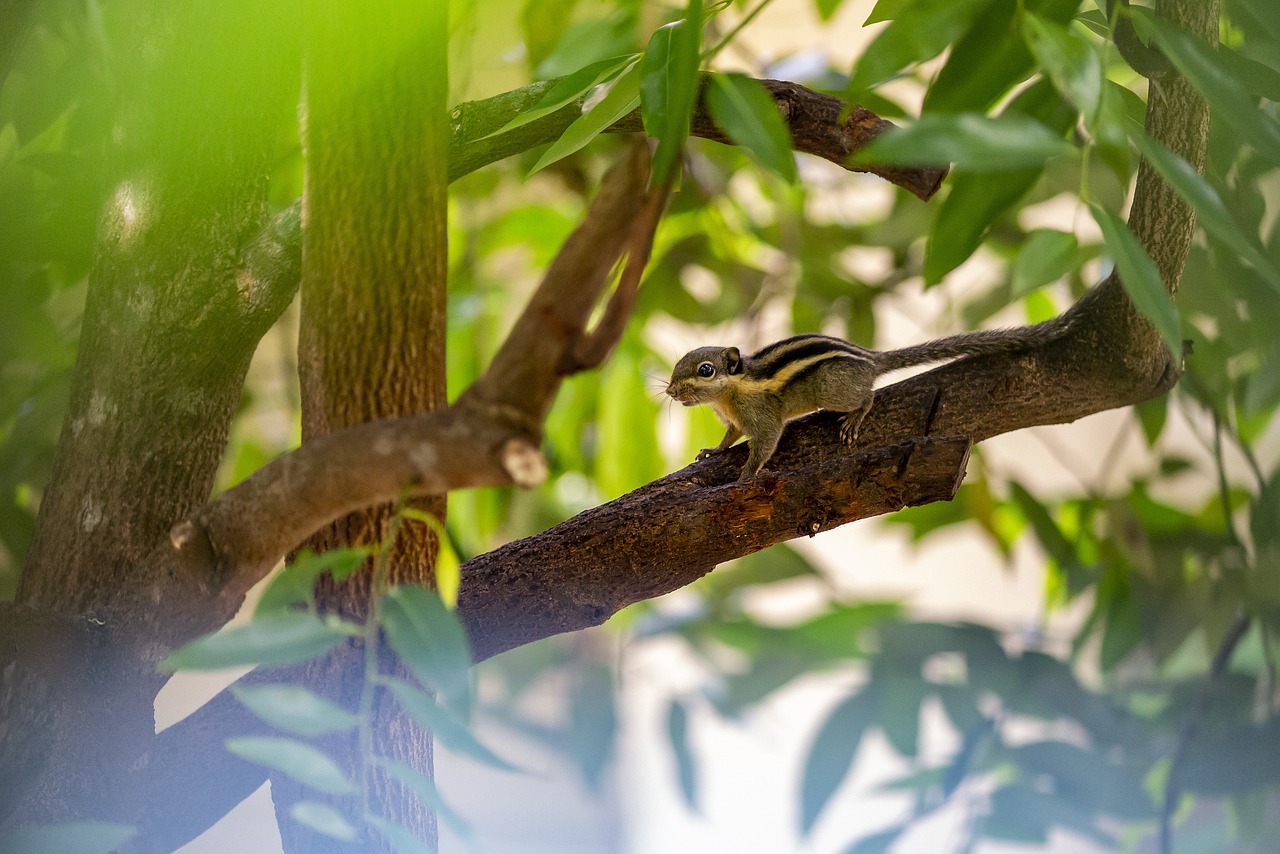Here’s a detailed overview of the Himalayan Striped Squirrel (Tamiops mcclellandii) — a lively, tree-dwelling rodent found across the forests of South and Southeast Asia.
🐿️ Himalayan Striped Squirrel (Tamiops mcclellandii)
Taxonomy
- Kingdom: Animalia
- Phylum: Chordata
- Class: Mammalia
- Order: Rodentia
- Family: Sciuridae
- Genus: Tamiops
- Species: Tamiops mcclellandii
Common Names:
- Himalayan Striped Squirrel
- Western Striped Squirrel
- Burmese Striped Squirrel
- McClelland’s Squirrel
General Description
The Himalayan Striped Squirrel is a small, agile tree squirrel easily recognized by its distinct longitudinal stripes and energetic behavior. It’s a diurnal species often seen darting along trunks and branches in search of food.
- Body length: 12–18 cm
- Tail length: 10–15 cm (bushy, often nearly as long as the body)
- Weight: 40–60 g
- Coloration:
- Back: Reddish-brown or olive-gray
- Stripes: 3 dark brown or black dorsal stripes separated by pale yellow or whitish lines
- Belly: Pale gray or white
- Tail: Bushy, with fine black and brown hairs giving a speckled look
- Face: Prominent light and dark stripes from the nose through the eyes — giving a masked appearance.
Distribution
Widespread in the forested regions of southern Asia.
- Native range:
- Himalayas: Nepal, Bhutan, northern India (Sikkim, Assam, Arunachal Pradesh)
- Southeast Asia: Myanmar, Thailand, Laos, Vietnam, southern China (Yunnan, Guangxi), and Taiwan
- Possibly found in northern Malaysia
- Altitude range: From sea level up to 3,000 meters, depending on region.
Habitat
- Prefers evergreen forests, subtropical woodlands, pine forests, and mixed mountain forests.
- Common in secondary growth, gardens, and plantations near forest edges.
- Often observed in canopies and lower branches, but also descends to the ground to forage.
Behavior and Ecology
- Activity: Diurnal (active during the day), especially mornings and late afternoons.
- Locomotion: Excellent climber and jumper; moves swiftly between trees using its long tail for balance.
- Social structure: Usually solitary or in small family groups.
- Vocalization: Emits sharp chattering calls or trills, especially when alarmed.
Diet
Omnivorous but primarily herbivorous:
- Main foods: Seeds, fruits, berries, nuts, and buds.
- Also eats insects, bark, and occasionally fungi.
- Plays a key ecological role in seed dispersal.
Breeding
- Breeding season: Generally twice a year, often in spring (March–May) and autumn (September–October).
- Gestation period: ~40 days.
- Litter size: 2–5 young per litter.
- Nests: Built in tree holes or among dense foliage, lined with leaves and plant fibers.
Young squirrels become independent within 2–3 months.
Predators and Threats
- Predators: Birds of prey (owls, hawks), snakes, and small carnivores.
- Defense: Agile climbing and freezing in place; uses alarm calls to warn others.
- Threats:
- Habitat loss due to logging and agricultural expansion.
- Local hunting in some areas.
- However, populations remain stable in most regions.
Conservation Status
- IUCN Red List: 🟩 Least Concern
- Population trend: Stable and widespread.
- Adaptable to secondary habitats and disturbed forests, making it resilient to moderate habitat alteration.
Interesting Facts
- The genus Tamiops differs from Funambulus (the Indian palm squirrels) by smaller size, shorter ears, and distinct stripe patterns.
- The species was named after the Scottish naturalist John McClelland, who studied Asian fauna in the 19th century.
- In Thailand and Malaysia, they are sometimes seen alongside plantain squirrels (Callosciurus notatus), but are smaller and more striped.
- Their rapid tail flicking and chirping are used both for communication and predator distraction.
Identification Summary
| Trait | Description |
|---|---|
| Size | Small (12–18 cm body) |
| Color | Brown to reddish with white underside |
| Stripes | 3 dark dorsal stripes separated by pale lines |
| Tail | Bushy, nearly body-length |
| Habitat | Forests, gardens, hills up to 3000 m |
| Behavior | Active, agile, diurnal, seed disperser |
Visited 880 times, 5 visit(s) today
Views: 1518
Subscribe to the newsletter:
